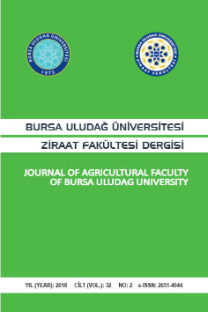Tavuk ve hindilerde turkey rhinotracheitis virus (TRTV) antikorlarının ELISA ile belirlenmesi
Bu çalışmada, Güney Marmara Bölgesi'ndeki tavuk ve hindi kümeslerinden elde edilen 735 serum örneği, indirelct ELISA tekniği ile anti-TRTV antikorlarının varlığı yönünden incelendi. Bu amaçla ticari ELISA kiti (Avisure Art Avian Rhinotracheitis- Vetoqumol Diagnostics) kullanıldı. Klinik hastalık tablosu görülen 9 adetbroyler ve 7 adet broyler damızlık işletmesinden toplam 426 kan serumu alın-dı. Çalışına süresince TRT klinik semptomu gösteren hindi kümesi tespit edilemedi. Klinik olarak sağlıklı hayvan grubu için 137 adet broyler ve 172 adet hindi kan serumu test edildi. Serolojik inceleme sonuçlarına göre, infeksiyondan şüpheli 8 adet broyler işletmesinde %31.8 -75.9, broyler damızlıklarda ise %5.4 - 48.6 oranlarında anti-TRTV antikorları saptandı. İnfeksiyonun klinik semptomları; periorbital ödem, baş ve submandibular bölgede şişkinlik, gözlerde kapanma, konjuktivitis, oküler akıntı ve çapaklanma, nasal akıntı ve kurumadan dolayı burun deliklerinde tıkanma şeklinde gözlendi. Broyler damızlıklarda ayrıca inkoordinasyon, opisthotonus ve baş bölgesin-de titreme dikkat çekiciydi. Broyler kümeslerde mortalite % l - 7 iken, broyler damızlıklarda %2.4 - 20 oranında mortalite ve %4 - 5 oranında yumurta verim düşüklüğü ile birlikte 1-2 hafta içinde iyileşme gözlendi. Hastalık broylerlerde 21-41'nci günlerde, broyler damızlıklarda ise 35-60'ncı haftalarda saptandı. Sağlıklı hayvan grubunu oluşturan toplam 10 adet broyler kümesin 7 adedinde %5.5 - 80 oranlarında anti-TRTV antikorları saptandı. Otuz-34 haftalık 4 adet besi hindi kümesinin üçünde ve 36-38 haftalık 6 adet damızlık hindi kümesinin ikisinde sırası ile %20, %24 ve %57; %10.5 ve %11.1 oranlarında anti-TRTV antikorları bulundu.
Anahtar Kelimeler:
etlik piliç, kümes hayvanları, rinotrakeit, seroprevalans, şişmiş baş sendromu, hindi, ELISA, antikor, ölüm oranı
Detection of antibodies to turkey rhinotracheitis virus (TRTV) in chicken and turkey using ELISA
In this study, 735 serum samples obtained from chicken and turkey flocks in North Marmara Region were tested for the presence of antibodies to TRTV by using the indirect ELISA. A commercial ELISA kit (Avisure Art Avian Rhinotracheitis- Vetoquinol Diagnostics) was used for this purpose. A total of 426 serum samples were collected from 9 broiler and 7 broiler breeders flocks, which showed clinically disease sings. During the study, turkey flocks showing clinical sings of TRT were not detected. One hundred and thirty seven broiler sera and 172 turkey sera were tested for clinically healthy groups. The antibodies to TRTV in 8 broiler flocks, which were suspected to be infected, were found between 31.8% and 75.9% and in broiler breeder flocks were found between 5.4% and 48.6%, according to serological investigation. The following symptoms has been delected: .Periorbital oedema, swelling of head and submandibular regions, closed eyes due to swelling, conjunctivitis, öcüler discharge and gummies in eyes, nasal discharge and blockage of nares due to the dryness. In addition, ^coordination, opisthotonus and shaking of the head were remarkable in broiler breeders. Broiler breeder flocks with 2.4% to 20% mortality and 4% to 5% loss of egg production recovered within 1 to 2 weeks while mortality was 1% to 7% in broiler flocks. The disease was observed at 21 to 41 days of age in broilers and 35 to 60 weeks of age in broiler breeder. The antibodies to TRTV were detected between 5.5% and 80% in 7 out of 10 cl'nically healthy groups of broiler flocks. The antibodies to TRTV for the three of the four fattening turkey flocks (30 to 34 weeks old) and the two of the six breeder turkey flocks (36 to 38 weeks old) were found 20%, 24% and 57%; 10.5% and 11.1 %, respectively.
Keywords:
broilers, poultry, rhinotracheitis, seroprevalence, swollen head syndrome, turkeys, ELISA, antibodies, mortality,
- ISSN: 1301-3173
- Yayın Aralığı: Yılda 2 Sayı
- Başlangıç: 1981
- Yayıncı: Ahmet Akkoç
Sayıdaki Diğer Makaleler
Döl tutmayan inek ve düvelerde penetrasyon testinin kullanım olanakları
Infertilite problemi olan atlarda bakteriyolojik incelemeler
Mihriban ÜLGEN, Seyrek Kamil İNTAŞ, Levent KOCABIYIK, Mehmet UZAN
İvesi koyunlarında flushing ve sinkronizasyon uygulamalarının döl verimi üzerine etkisi
ORHAN ÖZBEY, PINAR TATLI SEVEN
Functional forms of the muscle bundles belong to external eye muscles in human and sheep
BAHRİ YILDIZ, HÜSEYİN YILDIZ, İhsaniye İKİZ
Kırmızı toz biberlerde aflatoksin
Hıdır DEMİR, MUSTAFA ÖZCAN, FERHAN KAYGISIZ, İsmail ABAŞ, BÜLENT EKİZ
Bursa' da tüketime sunulan bazı baharatların mikrobiyal florası
